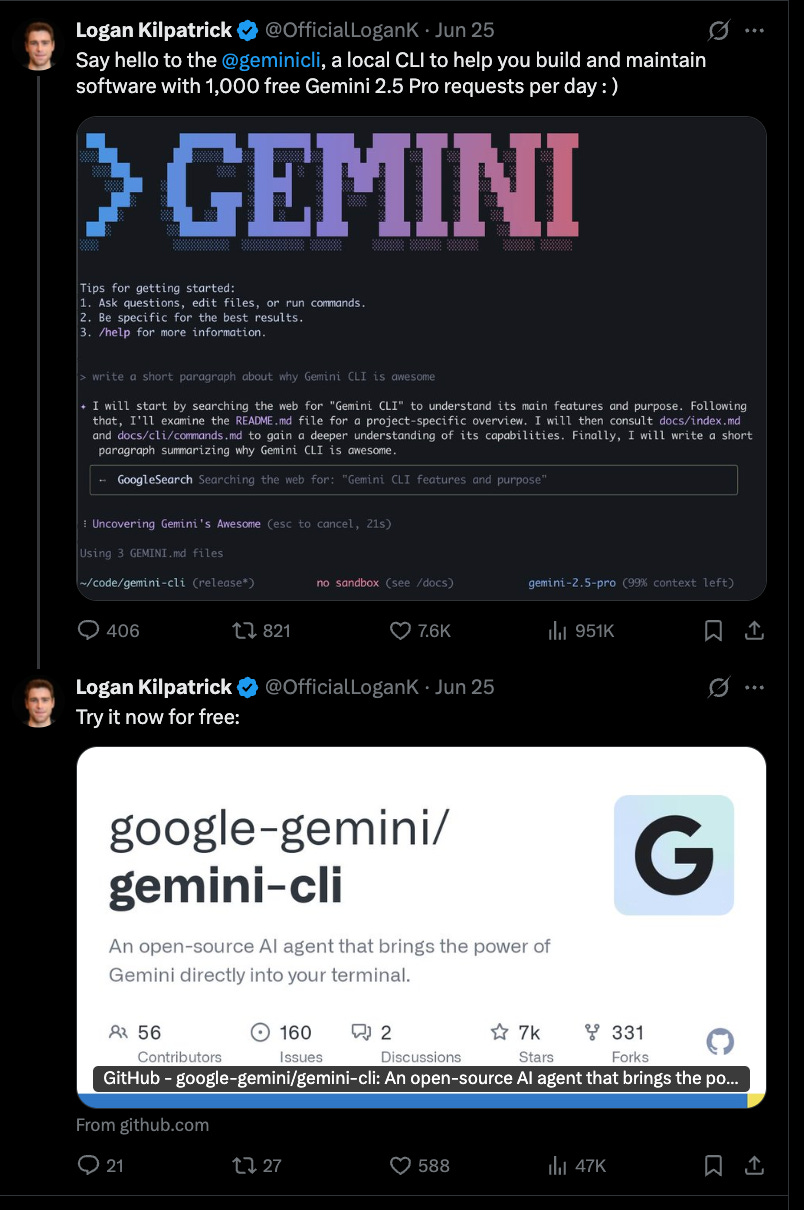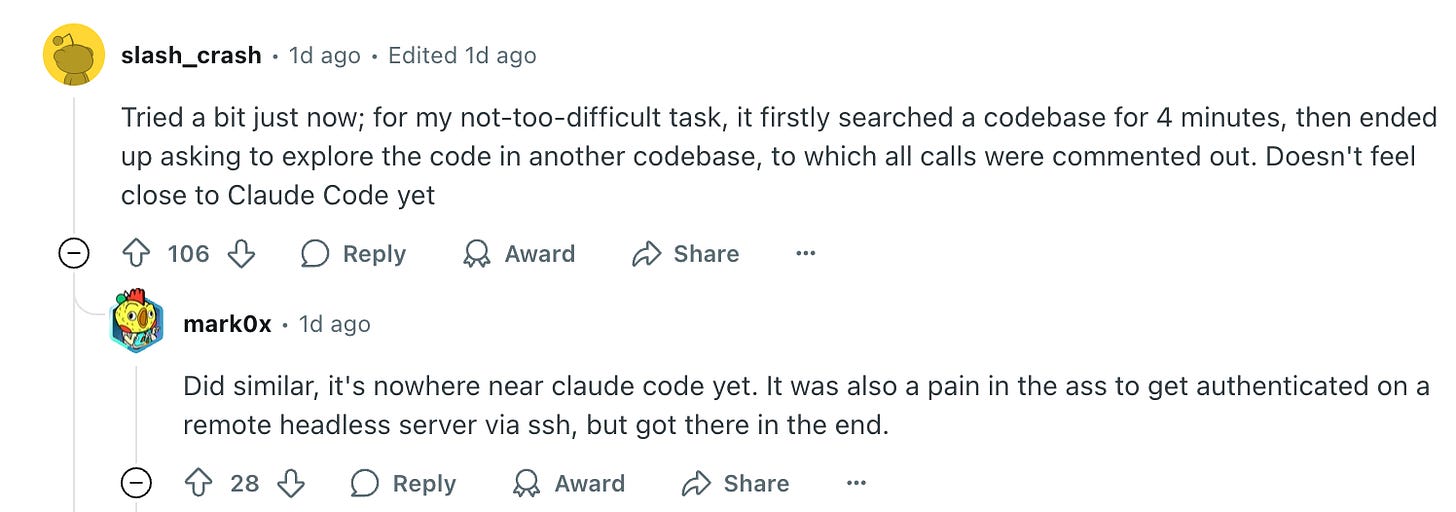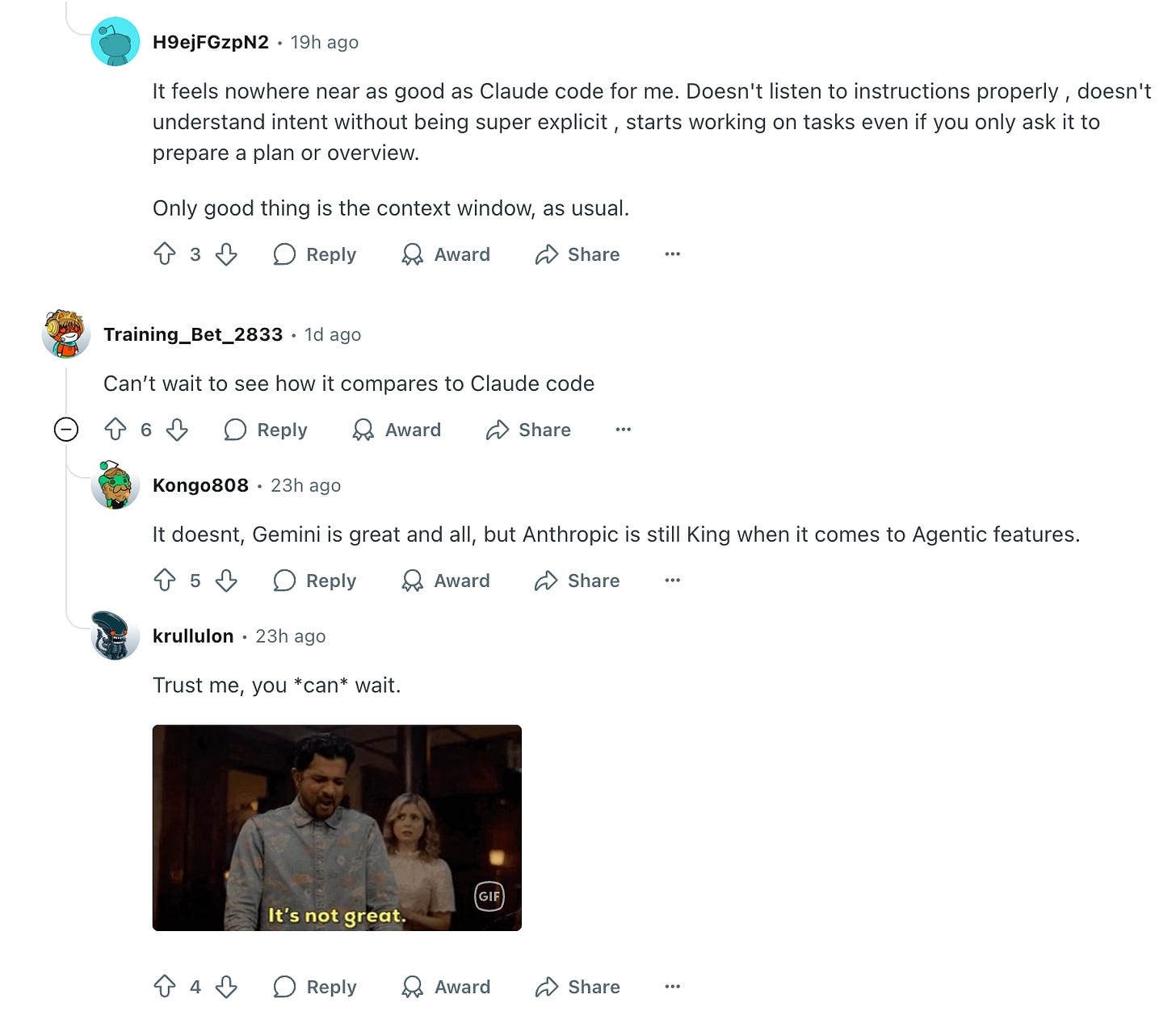AI Coding Wars Hit Terminal Velocity
Google just shipped a terminal-native agent. The interface war is on.
Google just launched Gemini CLI - a command-line interface backed by Gemini 2.5 Pro. It’s multimodal, context-rich, and wildly generous:
1M token context window
60 requests/min
1000 queries/day
Built-in grounding via Google Search, Imagen/Veo, and Workspace extensions
All for free.
With this release, all three frontier labs - OpenAI, Anthropic, and now Google - have launched official CLI-native agents. We’ve moved past the model race. We’re in a full-blown battle to own the developer operating system.
(1) Capitalism > Kindness
Here’s the pop quiz: what does Google have that OpenAI and Anthropic don’t?
An ad business. A cloud platform. A mobile OS. And perhaps most importantly: infinite runway.
Google doesn’t need to raise a Series G. It doesn’t need your $20 or $200 a month. It just needs to win - and ensure you never even consider going elsewhere.
By contrast, Claude Code - Anthropic’s excellent CLI agent - costs users up to $200/month for a 200K-token context window. Gemini CLI offers 5x the context for $0. Don't mistake this for generosity.
(2) Portal > Product
Gemini CLI isn’t just a dev tool. It’s an on-ramp into Google’s ecosystem. You’re tapping into:
Google Search for live grounding
Imagen + Veo for visual generation
Gmail, Calendar, Docs for organizational memory
Drive, Firebase, Cloud Run for file access and deployment
Most AI tools live in your codebase. Gemini wants to live in your workflow. It’s not just multimodal - it’s multi-surface, spanning the full context of how and where work gets done.
(3) Interfaces Are the New Frontier
The first phase of AI coding tools focused on the model arms race: bigger, faster, cheaper. Phase two is all about interface control.
Every serious AI dev tool today is implicitly answering the same question:
What’s the right interface for AI-native development?
The answers are diverging into four distinct bets:
IDE-native: Tools like Cursor and Windsurf aim to layer AI into the familiar rhythm of VS Code. Minimal disruption, maximal adoption - but limited by the confines of legacy UX.
Browser-native: Products like v0.dev, Replit, and Lovable reimagine creation as conversation - spinning up web or mobile apps directly from prompts. Great for velocity, less so for long-term maintainability and scalability.
Terminal-native: Claude Code, Codex CLI, and now Gemini CLI target the command line - the stronghold of high-leverage developers. These tools prioritize transparency, control, and composability.
Full-stack AI teammates: Devin, Factory, and similar efforts seek to transcend interface categories altogether - aiming to be autonomous collaborators that handle tasks across tools and surfaces.
At first glance, CLI tools might seem like a throwback. But this isn’t sentimentality - it’s strategy. The terminal mirrors the Unix philosophy: composable, auditable, close to the system. It’s where trust is highest, cognitive overhead is lowest, and workflows are deeply ingrained.
(3) The Philosophical Divide
Underneath these interface bets are 2 competing philosophies.
One camp (usually the AI teammate cohort) argues we’re forcing intelligence into outdated metaphors - autocomplete boxes and bash scripts. They want a ground-up reimagining: new tools, new abstractions, new workflows. They often quote Henry Ford: “If I’d asked people what they wanted, they’d have said faster horses.”
But the other camp is betting that change must be invisible before it becomes inevitable and that real adoption starts with familiarity.You don’t convert developers by asking them to unlearn decades of muscle memory. You meet them where they are. Then shift the ground beneath them.
I don’t know which worldview wins - reinvention or incrementalism - but Gemini CLI tells us where Google stands. And when a company with this much distribution, infrastructure, and capital makes a move, it's worth watching.
Curious to see how the dev community responds this week.
Early feedback echoes what I’ve heard privately - promising start, impressive integration…
…but Claude’s still king. For now.
The initial phase of the AI software development race orbited around models. Bigger, faster, cheaper — the usual benchmark race. But the next wave of competition is shifting from model supremacy to interface dominance.
4 Interfaces, 1 Debate. Today, every AI dev tool is, implicitly or explicitly, answering one question: What’s the right interface for AI coding? Some re-invent the IDE, others take you from prompt to product in browser, and then there are those that want to build ‘AI as a teammate’ and cut across all interfaces to create an end to end agent. The foundation model companies are betting on the 4th: embedding directly into the Terminal with CLI agents. This mirrors the Unix philosophy: composable, transparent, close to the system. It’s where high-leverage devs already live, and where agentic workflows (edit > test > commit) can be orchestrated cleanly.
These AI coding tools aren’t just competing on UX. They’re competing on worldviews. Should we rebuild the interface for an AI-native future?
Or should we meet devs where they are, and bring intelligence into existing tools?Some founders argue that we’re squishing intelligence into outdated metaphors — forcing AI into autocomplete boxes and bash scripts. We need a ground-up reimagining, they say. New interfaces. New mental models. New workflows.
They echo Henry Ford: “If I’d asked people what they wanted, they’d have said faster horses.”
But the other camp — and it seems, the big model companies — aren’t buying it.
They believe change must be incremental to be adopted. Meet the user where they are — and evolve together. First augment, then reinvent.Google made its stance clear:
“For developers, the command line interface (CLI) is home.”
That’s why Gemini CLI matters.
It’s not a tool designed to wow you with novelty.
It’s designed to slip in quietly, live where you already work — and slowly reshape what “working” means.Generosity of Spirit — or Competitive Aggression. Pop quiz. What does Google have that OpenAI and Anthropic don’t? infinite runway. Google doesn’t need to raise a Series G. It doesn’t need to charge you $20 or $200. It just needs to win — and make sure you never even consider going elsewhere.
And so they’ve offered unmatched usage limits for this agent. Compare that to Anthropic, whose Claude Code is widely considered the best AI coding experience today — but comes at $200/month for 200K token context. That’s not kindness. That’s strategy.
Plugged In, Multimodal, and Omnipresent. There’s one more reason Gemini CLI matters: more than a code agent, It’s a portal into Google’s ecosystem:
When you use Gemini CLI, you’re not just prompting a model. You’re tapping into:
Google Search
Your Gmail, Calendar, Docs (eventually)
Image and video generation (Imagen, Veo)
Workspace and Drive extensions
App hosting (Firebase, Cloud Run)
It’s not just that it can help you write code.
It’s that it can help you deploy it, explain it, visualize it, schedule it, and support it - using assets from across your stack, personal or professional.This is what neither OpenAI nor Anthropic can fully offer yet:
A model that’s multimodal, multi-surface, and already embedded in your digital life.






